Everything you can do with the Apple HomePod
Posted on
by
Kirk McElhearn
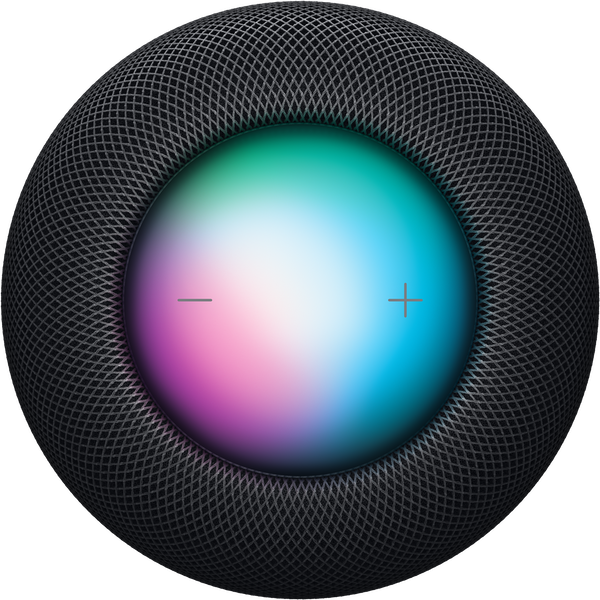
As smart speakers go, Apple’s HomePod has a few points that make it stand out. It has better sound than many Alexa and Google Home devices. There are a number of smart speakers made by audio companies that focus on sound quality, and which include the ability to use one or more of the voice assistants, but the HomePod is the only smart speaker with premium audio that uses Siri. If you’re in the Apple ecosystem, this is a compelling reason to use it.
As for the HomePod mini, this $99 device lets you access all the Siri and smart home features without the great sound. It just has one speaker compared to the six speakers (one woofer and five tweeters) in the 2nd generation HomePod; you don’t buy a HomePod mini for its audio quality, though a stereo pair of HomePod minis sounds pretty good.
In this article, I’m going to tell you what you can do with your HomePod or HomePod mini: how you can tell it to play music, give you information, make phone calls, and more.
How to set up an Apple HomePod
To set up your HomePod, hold your iPhone near the device and follow the instructions. This can take a few minutes, and, with a new HomePod, the device may have to download a software update.
When this is done, go to the Home app on an iOS device, tap Rooms, select the room where you’ve assigned your HomePod, then press and hold the HomePod’s tile. Tap Accessory settings, and a screen displays showing the device’s settings. On the Mac, right-click on the HomePod’s tile and choose Accessory Details to see the same information. (Note: the screenshots below show a stereo pair of HomePods; I explain how to connect two HomePods to play in stereo below.)
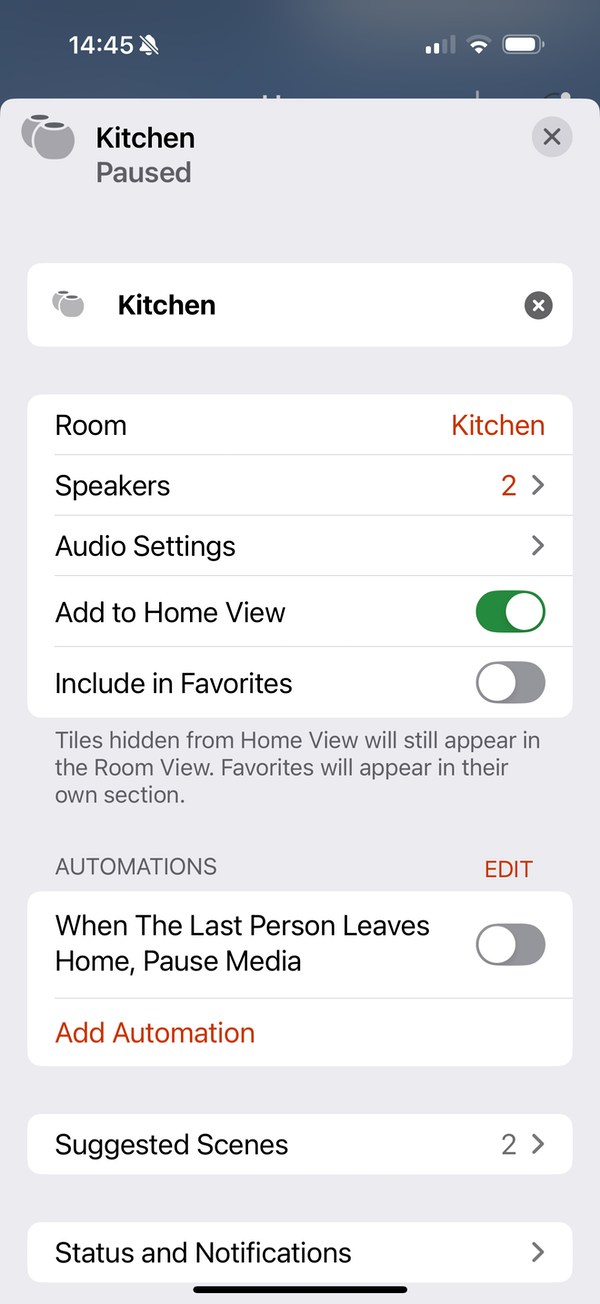
You’ll see a number of settings here, such as the name of the device, the room where it’s located, whether it’s in the main Home view or a Favorite, and more. Swipe up a bit, and you’ll see information about the account it uses to access both music – if you have Apple Music, or use Cloud Music Library – and your personal information.
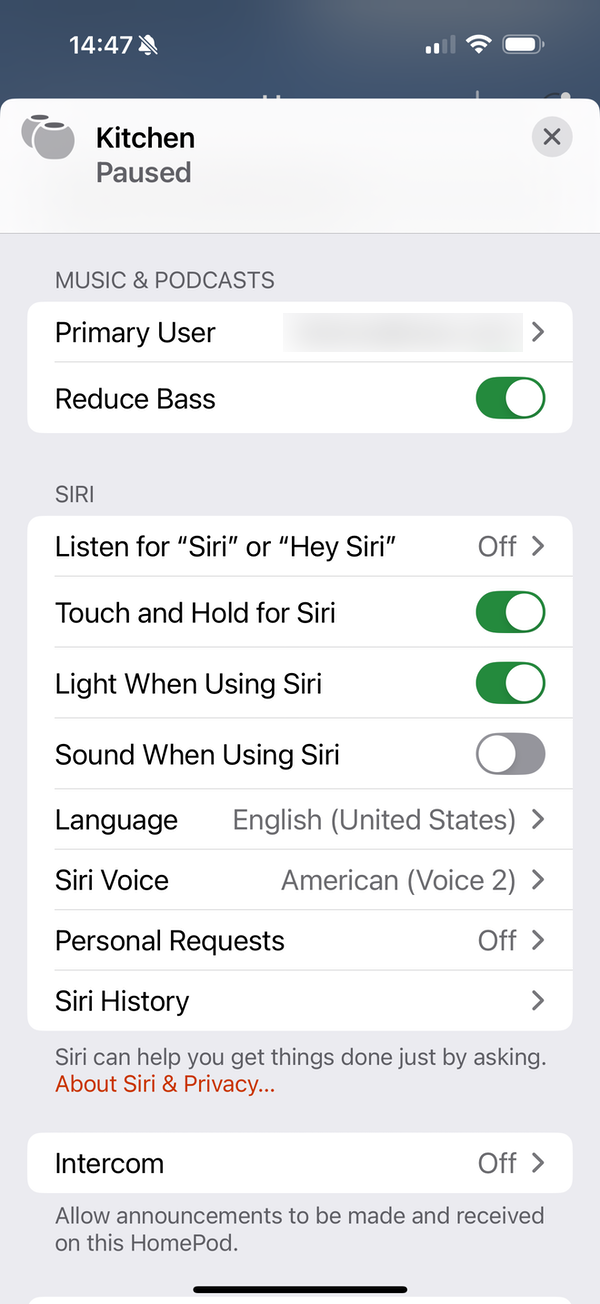
You’ll also see Siri settings. If you want to be able to use Hey Siri, you can toggle it on here; if not, you can access Siri by tapping and holding the top of the device. (And if you do this, you don’t need to say “Hey Siri” with each command.) You don’t have to use Siri; if not, you will only be able to play music on the device by sending it via AirPlay from an iOS device or a Mac, or by bringing your iPhone or iPad near a HomePod.
Note the Reduce Bass setting near the top of the above screenshot; toggle this on if you find that your HomePod sounds too bassy.
If you scroll down a bit more, you’ll see settings for the Intercom feature. I discuss this below.
Set up two HomePods as a stereo pair
HomePods don’t play music in stereo; even though the larger HomePod has multiple speakers in its enclosure, it’s still just mono. But you can set up a stereo pair of two HomePods, which then works like a pair of stereo speakers, with one playing the left channel and the other playing the right channel of audio.
To do this, set up both HomePods in the same room, then, from the Settings screen above, tap Create Stereo Pair. The Home app will ask you to confirm which HomePod is the left channel and which is the right, then, after a minute or so, the stereo pair will be configured. When you play music, you see both HomePods as a single entry in the Home app and in AirPlay menus. If you use Siri commands, only one HomePod responds to these requests, plays alarms and acts as a speakerphone.
How to play or stream music on a HomePod
The HomePod’s main use is to play music, and, while the HomePod mini’s audio quality is greatly inferior to that of its larger sibling, you can listen to music on it.
You can play music with Siri in a number of ways. For example:
- Hey Siri, play the new Taylor Swift album.
- Hey Siri, play some upbeat music.
- Hey Siri, play some classic rock.
- Hey Siri, play the Frozen soundtrack.
You can also have Siri play your “personal radio station” if you use Apple Music. Just say, “Hey Siri, play some music.” This will play a selection of music from your music library, music you have loved, and some related tracks. It’s a good way to play music when you don’t know what you want to listen to.
While playing music on a HomePod, you can tell Siri to pause the music or resume it, skip tracks, and you can also control the volume. The HomePod has a seemingly miraculous ability to hear commands, even when the music is loud. You can use the following:
- Hey Siri, next song.
- Hey Siri, make it louder.
- Hey Siri, set the volume to 50%.
- Hey Siri, stop.
You saw above that there’s a setting to reduce bass on the HomePod. You can say, “Hey Siri, turn off bass” or “Hey Siri, turn on bass” to toggle that setting.
There are lots of other Siri commands you can use for music; see this Apple document for more.
How to send audio to a HomePod via AirPlay
What if you want to play some music on your iPhone, or play audio from another app? Since the HomePod uses Apple’s AirPlay protocol, you can stream music to it. To do this, start playing some audio, then tap the round AirPlay icon at the bottom of the play screen. You’ll see an interface like this; choose which speaker(s) you want to play the music on. Here, I’m streaming music from my iPhone to the HomePod in my living room.
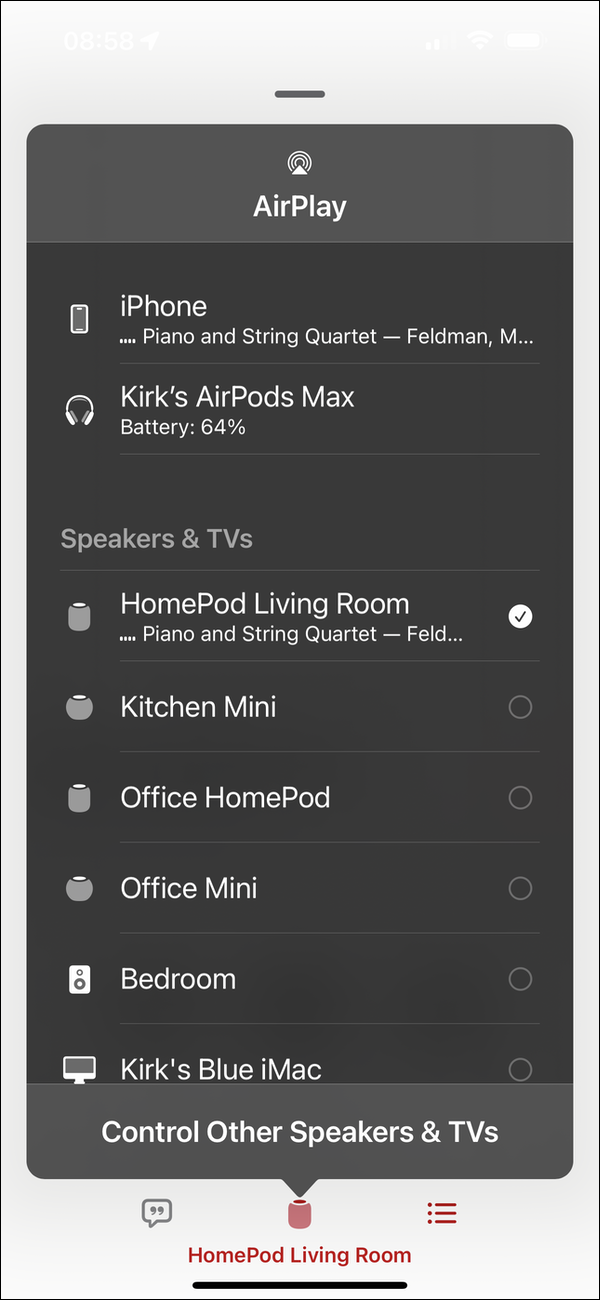
Since I don’t like having Siri active on my HomePods, and since Siri isn’t great at understanding my music requests, I select music on my iPhone or iPad, then stream it to the HomePod in this manner. I can also easily control it from my iPhone: adjusting the volume, pausing, skipping songs, and more. The AirPlay interface allows you to play music and stream to multiple speakers, so if you have HomePods, or other AirPlay speakers in multiple rooms, just tap each one to select them. You can also do this if you’re watching a movie on an iPad in a room with one or two HomePods.
You can also play music in Dolby Atmos immersive audio format on the HomePod, if you subscribe to Apple Music. Not all music is available in Dolby Atmos format, also called Spatial Audio, but most new music is mixed for immersive audio.
How to hand off music and other audio from an iPhone to a HomePod
Another way to do play audio on a HomePod is to start playing music on your iPhone, then bring the iPhone a few inches from the HomePod; this will “hand off” the music to the HomePod, streaming it from that speaker. The iPhone displays a dialog showing that the HomePod has started playing the music.
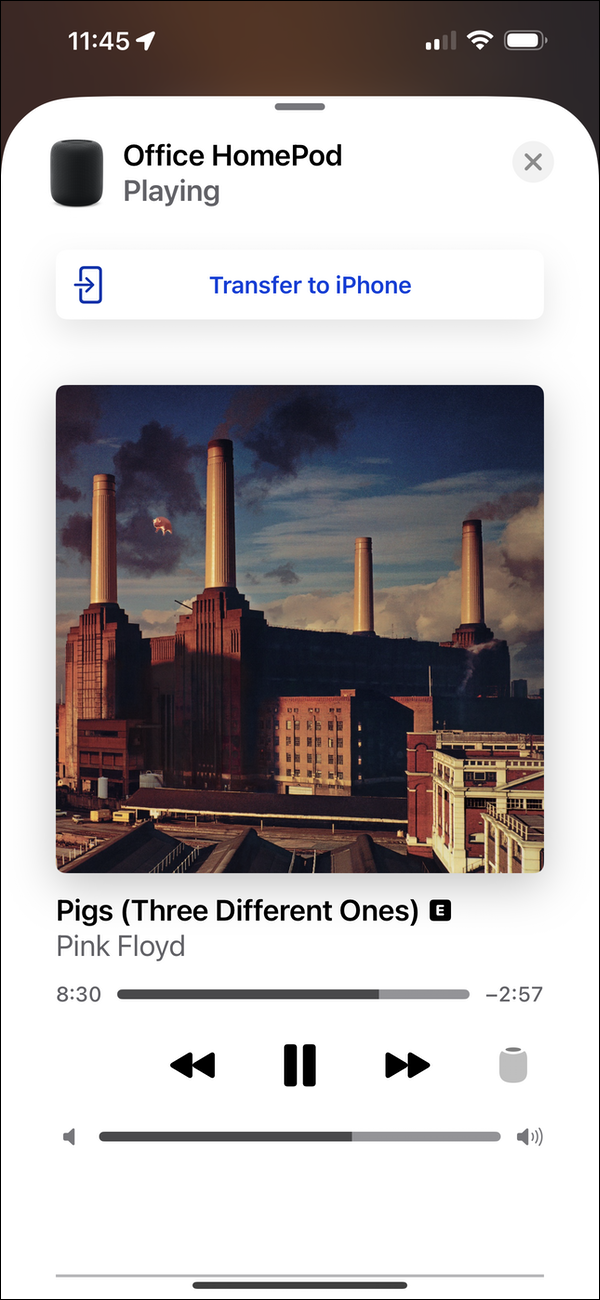
This is essentially a shortcut to sending audio via AirPlay; you can hand off any audio that’s playing on your iPhone to the HomePod.
And if you’re listening to audio on the HomePod, you can tap your iPhone to hand the music off to the phone.
How to play podcasts and other audio on HomePod

You can also use Siri to tell the HomePod to play podcasts: “Hey Siri, play Fresh Air.” Or if you want to hear the news, say “Hey Siri, what’s in the news today?” You can request specific news sources, such as, “Hey Siri, play NPR News,” or “Hey Siri, play the sports news.”
The HomePod can also play some ambient sounds, such as rain, stream, forest, ocean, white noise, fireplace, and night. Say, “Hey Siri, play forest sounds” to have a relaxing background.
And, as you saw above, you a send any audio via AirPlay to a HomePod, from an iPhone, iPad, or Mac, and you can hand off podcasts played with any app to the HomePod.
How to control your smart home with HomePod

Anything you can do to control your smart home with Siri on an iPhone or iPad is also available via the HomePod. For example, if you’ve set up some smart lights in the Home app, you can tell Siri to turn them on or off:
- Hey Siri, turn on the living room lights.
- Hey Siri, turn off the outdoor light.
The 2nd generation HomePod and the HomePod mini also have temperature and humidity sensors. You can ask your HomePod, “Hey Siri, what’s the temperature?” and it will tell you. You can even ask Siri on your iPhone what the temperature is in a room, and you can do so even if you’re not home. Note that if you have multiple smart home devices with temperature settings, Siri may tell you that “It ranges from 19.4ºC to 21ºC in the Office,” for example.
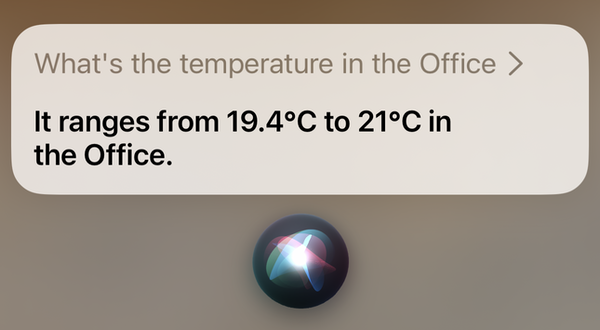
Siri can control any HomeKit compatible device; see this Apple document for more on the Home app and Siri.
And you can use your HomePod as a HomeKit hub:
Personal requests: Using HomePod as a virtual assistant

The HomePod can also handle “personal requests,” which means it can work with your messages, reminders, contacts, calendars, and notes. To use this feature, you must turn on Personal Requests in the settings; see the second screenshot in the settings section at the beginning of this article.
One Siri feature that I use all the time is reminders. When I’m cooking, and need to perform a task, I have Siri remind me. I say, “Hey Siri, remind me to check the oven in 20 minutes.”
But Siri can also do lots more. Here are some examples:
- Hey Siri, read my unread messages.
- Hey Siri, send a message to Angela, saying that I’ll be ten minutes late for our appointment.
- Hey Siri, add cardamom to my shopping list.
- Hey Siri, add a note called “Things to fix,” and Hey Siri, add “Replace kitchen light bulbs” to my “Things to fix” note.
- Hey Siri, what’s on my calendar today?
You can also set timers; this is great in the kitchen. Say “Hey Siri, set a timer for three minutes,” so your boiled eggs will be just exactly right.
And use alarms to have Siri wake you in the morning. “Hey Siri, wake me up at 6:30 am.” But if you don’t want to get out of bed right away, say “Hey Siri, snooze.”
For more about using Siri on the HomePod, see this Apple document.
How to make and answer phone calls on the HomePod

The HomePod can’t make phone calls itself, but if you have your iPhone nearby, it can function as a speakerphone. If your phone rings, say, “Hey Siri, answer the phone,” and you’ll be able to talk to your correspondent. When you’re finished, say “Hey Siri, hang up,” or tap the top of the HomePod.
To make calls, you can say, “Hey Siri, call Max,” if you have a contact named Max, or you can even read out a phone number, saying “Hey Siri, call 555-1247.”
Use the Intercom feature
The Intercom feature allows you to send voice messages to all the HomePods in your home. Each HomePod must have the Intercom feature turned on in its settings. (This setting is at the bottom of the second settings screenshot at the beginning of this article.)
To use this, say something like, “Hey Siri, ask everyone where are my glasses?” This message will be broadcast to all your HomePods. Anyone can reply by saying, “Hey Siri, intercom…” and then the rest of their message.
Get alerts for smoke alarms and carbon monoxide detectors
HomePods can recognize certain sounds, such as those of smoke alarm and carbon monoxide detectors. To enable this feature, in the Home app, tap … at the top right, then tap Home Settings. Tap Safety & Security, then enable Sound Recognition. If a HomePod hears an alarm, it will send a notification to all devices that are signed into that HomePod. The notification says CRITICAL and shows which HomePod has detected the alarm.
Getting the most out of the HomePod and HomePod mini
As you’ve seen above, the HomePod is a great way to play music but is also a powerful tool for using Siri. Learn about its many features so you can leverage it to make your day smoother.
How can I learn more?
To learn more about the Apple HomePod, be sure to check out our full review of the original Home Pod:
Our review of the HomePod mini:
And our review of the 2nd generation HomePod released in January 2023:
And if you’re interested in the HomePod’s smart home features, check out this article on how to use Thread HomeKit devices:
 Each week on the Intego Mac Podcast, we discuss topics like the ones covered in this article, as well as the latest Apple security and privacy news. Be sure to subscribe to make sure you never miss the latest episode!
Each week on the Intego Mac Podcast, we discuss topics like the ones covered in this article, as well as the latest Apple security and privacy news. Be sure to subscribe to make sure you never miss the latest episode!
Also subscribe to our e-mail newsletter and keep an eye here on The Mac Security Blog for updates.
And make sure you’re following Intego on your favorite social and media channels: Facebook, Instagram, Twitter, and YouTube (click the 🔔 to get notified about new videos).